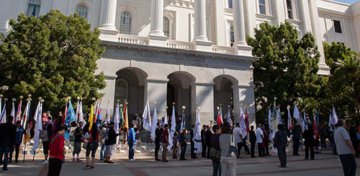Tribal Relations

Native American Day at the California State Capitol, September 22, 2017. Flag bearers carry the flags of California’s Tribal Nations in front of the California State Capitol in Sacramento. Photo by HSR.
The United States recognizes Indian tribes as sovereign nations. As such, the federal government and Indian tribes have a unique government-to-government relationship, which is grounded in the U.S. Constitution, numerous treaties, statutes, federal case law, regulations, and executive orders that establish and define a trust relationship with Indian Tribes. In addition, the State of California has an important relationship with the many Native American tribes indigenous to the state, as set forth and affirmed in both state and federal law.
The State of California is committed to strengthening and sustaining effective government-to-government relationships with both federally-recognized tribes and other California Native Americans, as codified in the governor’s Executive Order B-10-11. Executive Order B-10-11 established the Governor’s Tribal Advisor in the Office of the Governor and further orders that every agency and department subject to the governor’s executive control shall encourage communication and consultation with California Indian Tribes and permit tribal representatives to provide meaningful input into the development of legislation, regulations, rules, and policies on matters that may affect tribal communities. The California High-Speed Rail Authority (Authority) acknowledges and reaffirms this commitment.
The Authority is responsible for planning, designing, building, and operating the nation’s first high-speed rail system, which will take the pressure off existing air and ground transportation infrastructure, reduce the state’s dependency on fossil fuels, and result in better air quality and community health in California. The Authority seeks to identify areas of mutual concern and work toward the development of partnerships and consensus with California Indian tribes. The Authority’s Tribal Relations web page and its content are intended to foster tribal awareness about the high-speed rail project, encourage tribal participation in the project planning process, and help establish connections for future consultations and collaboration between the Authority and California Indian tribes on individual high-speed rail sections during the project planning process.
NEPA Assignment MOU
California Governor Gavin Newsom and Federal Railroad Administration (FRA) Administrator Ronald Batory have signed a Memorandum of Understanding (MOU), by which the California High-Speed Rail Authority (Authority) has been assigned FRA’s responsibilities as lead agency under the National Environmental Policy Act (NEPA). Pursuant to Section 327 of Title 23 of the United States Code, effective July 23, 2019 the MOU is authorized under the Surface Transportation Project Delivery Program, otherwise known as NEPA Assignment.
The NEPA Assignment MOU provides that the FRA assigns, and the State assumes, environmental review responsibilities under NEPA and other federal environmental laws with respect to projects in California’s High-Speed Rail system and projects that directly connect to stations on the high-speed rail system, which include the Link Union Station and West Santa Ana Branch Transit Corridor projects in Los Angeles. The MOU also includes the ACEforward project in the Altamont Corridor Express system. These federal responsibilities will be performed by the High-Speed Rail Authority, with oversight by the California State Transportation Agency.
In performing the requirements specified in the NEPA Assignment MOU, the Authority must comply with all federal laws and regulations applicable to FRA’s work on the program. Although six other states have executed NEPA Assignment MOUs for highway projects, California is the only state to have executed NEPA Assignment MOUs for both highway and rail projects. Since 2007, Caltrans has performed as NEPA lead agency for highway projects and achieved significant time savings. Now, the Authority will be able to accelerate project delivery while protecting the environment, by conducting more efficient environmental reviews and approvals of the environmental documents required to advance the High-Speed Rail Program.


